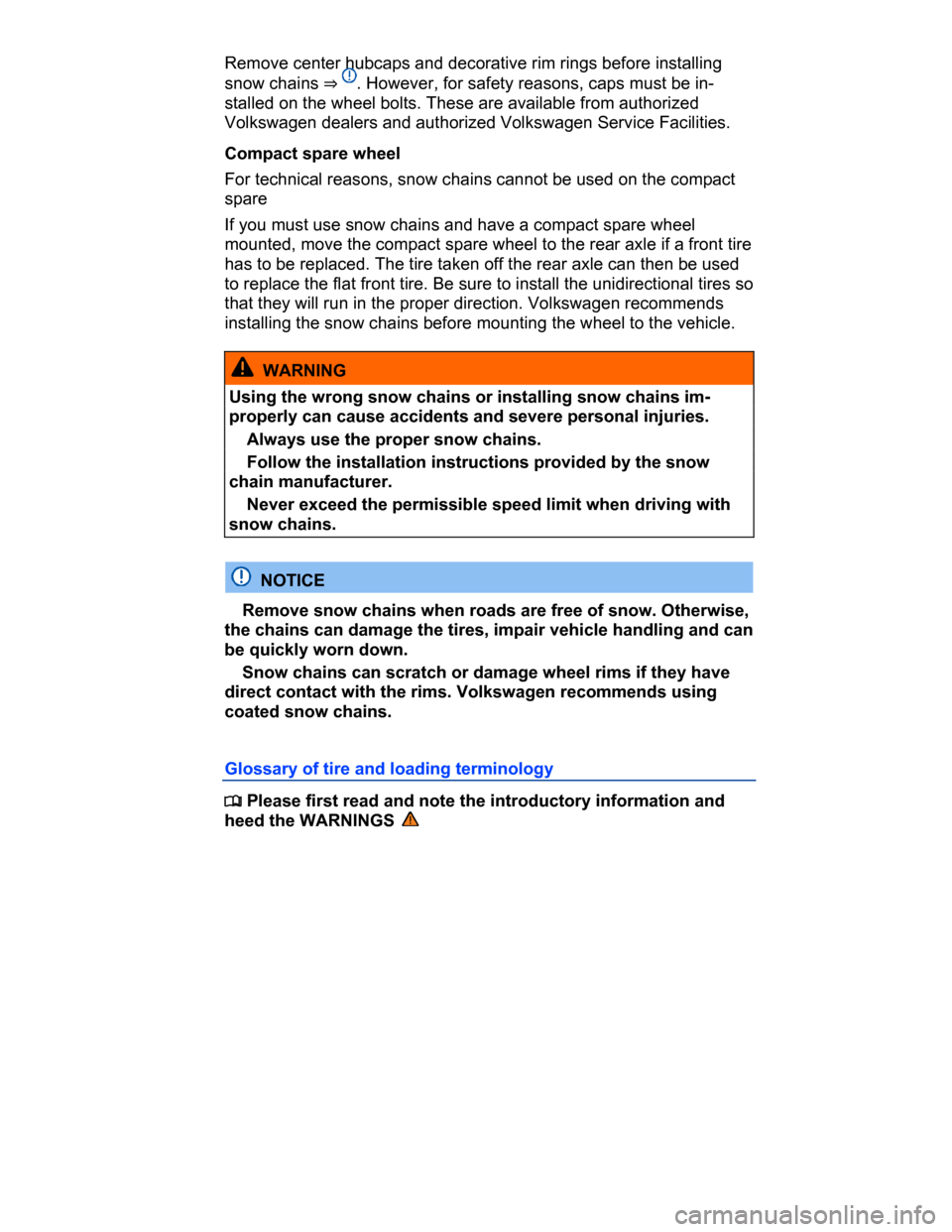Page 248 of 578
Tire labeling
(example)
Meaning
Brand, Logo Manufacturer
Tire name Individual tire designation of the manufac-
turer.
P255 / 55 R 18
Dimensions:
P Tire application: Passenger car
255 Nominal sidewall-to-sidewall width of
tire in millimeters.
55 Ratio of height to width (aspect ratio)
R Tire belt design letter code for radial.
18 Rim diameter (in inches)
109 H Load rating code and speed rating code
XL Indicates “reinforced” tire (heavy-duty)
M+S or M/S Indicates Mud and Snow capability (also
M/S) ⇒ Winter tires.
RADIAL TUBELESS Tubeless radial tire.
E4 ... Labeling according to international regula-
tions (E) including number of the approving
country. The multi-digit approval number is
listed next.
DOT BT RA TY5 1709
Tire identification number (TIN)3 – In some
cases the manufacturing date is only on one
side of the tire:
3 TIN represents the serial number of the tire.
Page 249 of 578
Tire labeling
(example)
Meaning
DOT
The tire complies with the require-
ments of the United States Depart-
ment of Transportation, responsible
for issuing safety standards.
BT Identification letter of the manufactur-
ing site.
RA Manufacturer information regarding
tire dimensions.
TY5 Tire characteristics provided by the
manufacturer.
1709 Manufacturing date: 17th week in
2009.
TWI Marks the position of the treadwear indicator
Made in Germany Country of manufacture.
MAX LOAD 615 KG
(1356 LBS)
United States maximum load rating per
wheel.
MAX INFLATION
350 KPA (51 PSI)
United States maximum permissible inflation
pressure.
ROTATION Rotation direction (unidirectional tires)
SIDEWALL 1 PLY
RAYON
Tire ply composition and materials used:
1 layer of rayon.
TREAD 4 PLIES
1 RAYON + 2 STEEL
+ 1 NYLON
Tire tread composition and materials used:
In this example there are 4 layers under the
tread: 1 layer of rayon, 2 layers of steel belt
and 1 layer of nylon.
Page 250 of 578

Tire labeling
(example)
Meaning
Consumer information regarding comparison to specified base
tires (standardized test procedure) ⇒ ⇒ page 284:
TREADWEAR 220 Relative service life expectancy of the tire
referenced to a U.S.-specific standard test.
TRACTION A Traction rating under wet conditions (AA, A,
B or C).
TEMPERATURE A Temperature stability of the tire at increased
test bench speeds (A, B or C).
Additional numbers found on the tire could either be tire manu-
facturer internal labels or country-specific labels (such as for
Brazil and China).
Unidirectional tires
Unidirectional tires are designed to rotate only in one direction. Unidi-
rectional tires have arrows on the sidewalls that show the direction of
rotation. Make sure you mount the tire so that it rotates in the proper
direction. The tire's performance with regard to hydroplaning, traction,
noise, and wear is worse if it is not mounted in the proper direction of
rotation.
If you have to mount a tire opposite to its proper direction of rotation,
you must drive more carefully, since the tire is no longer being used
as designed. This is particularly important on wet roads. You must
replace or remount the tire as soon as possible in order to restore the
correct direction of rotation.
Load rating code
The load index indicates the maximum permissible load per individual
tire in pounds (kilograms).
91 1356 lbs (615 kg)
92 1388 lbs (630 kg)
93 1433 lbs (650 kg)
95 1521 lbs (690 kg)
Page 251 of 578
97 1609 lbs (730 kg)
98 1653 lbs (750 kg)
99 1709 lbs (775 kg)
100 1763 lbs (800 kg)
101 1819 lbs (825 kg)
102 1874 lbs (850 kg)
103 1929 lbs (875 kg)
104 1984 lbs (900 kg)
110 2337 lbs (1060 kg)
Speed rating code letter
The speed rating code letter indicates the maximum permissible road
speed of the tires.
P up to 93 mph (150 km/h)
Q up to 99 mph (160 km/h)
R up to 106 mph (170 km/h)
S up to 112 mph (180 km/h)
T up to 118 mph (190 km/h)
U up to 124 mph (200 km/h)
H up to 130 mph (210 km/h)
V up to 149 mph (240 km/h)
Z over 149 mph (240 km/h)
W up to 168 mph (270 km/h)
Y up to 186 mph (300 km/h)
Some tire manufacturers label tires with a maximum permissible road
speed above 149 mph (240 km/h) with the letter combination “ZR.”
Page 252 of 578

WARNING
Using incorrect or unmatched tires and/or wheels or improper
tire and wheel combinations can lead to loss of control, colli-
sion and serious personal injury.
� Always use tires, wheels and wheel bolts that meet the speci-
fications of the original factory-installed tires or other combina-
tions that have been specifically approved by the vehicle manu-
facturer.
� All 4 wheels must be fitted with radial tires of the same type,
the same size (tread circumference), and the same tread pat-
tern. Driving with different tires reduces vehicle handling and
can lead to a loss of control.
� Never drive faster than the maximum speed for which the
tires installed on your vehicle are rated because tires that are
driven faster than their rated speed can fail suddenly.
� Overloading tires can cause heat build-up, sudden tire fail-
ure, including a blowout and sudden deflation and loss of con-
trol.
� Temperature grades apply to tires that are properly inflated
and not over- or underinflated.
Winter tires
�
Page 253 of 578

ter tire performance decreases with age – independent of the tread
profile depth.
When using winter tires:
� Obey state and country-specific legal requirements.
� Install winter tires on all 4 wheels.
� Use winter tires only under wintry road conditions.
� Only use winter tires with dimensions approved for the vehicle.
� Use only winter tires of the same tire belt design, the same dimen-
sions (tread circumference), and the same tread design.
� Follow speed restrictions according to the winter tire's speed rating
code letter ⇒ .
Speed restrictions
Winter tires are certified up to a top speed identified by speed rating
code letters on the side wall ⇒ Tire labeling.
In some vehicle models it is possible to set a speed warning in the
menu in the instrument cluster display ⇒ Volkswagen Information
System.
Top speed rating and tire inflation pressure for V winter tires depend
on the engine installed in your vehicle. Be sure to ask you authorized
Volkswagen dealer or authorized Volkswagen Service Facility about
the maximum permissible speed and the required tire inflation pres-
sure for the winter tires that you plan to use.
WARNING
Driving faster than the maximum speed for which the winter
tires on your vehicle were designed can cause sudden tire fail-
ure including a blowout and sudden deflation, loss of control,
crashes and serious personal injuries.
� Winter tires have a maximum speed rating that may be lower
than your vehicle's maximum speed.
� Never drive faster than the maximum speed for which the
winter tires installed on your vehicle are rated because tires
that are driven faster than their rated speed can fail suddenly.
� Never exceed the maximum load rating for the winter tires
installed on your vehicle.
Page 254 of 578

Install summer tires promptly in the spring. Summer tires offer
better handling characteristics for temperatures above +45 °F (+7 °C).
They are quieter, do not wear as quickly, and reduce fuel consump-
tion.
If factory-installed wheels and/or tires are replaced when in-
stalling winter tires, make sure that the wheels are equipped with
sensors that are compatible with the factory-installed Tire Pressure
Monitoring System and that the tires are also compatible with the sys-
tem. If new tires are not identical to those that were removed and re-
quire different cold tire inflation pressure, the tire inflation pressure
values must be reprogrammed for the TPMS. Please see your author-
ized Volkswagen dealer or authorized Volkswagen Service Facility ⇒
The Tire Pressure Monitoring System must be recalibrated whenever
you remove and remount or change any wheel or tire on the vehicle,
even if the reinstalled or replacement wheels and tires are identical to
those that were removed and even if the tire pressure does not
change.
If necessary, ask your authorized Volkswagen dealer or author-
ized Volkswagen Service Facility about permissible winter tire dimen-
sions.
Snow chains
�
Page 255 of 578

Remove center hubcaps and decorative rim rings before installing
snow chains ⇒ . However, for safety reasons, caps must be in-
stalled on the wheel bolts. These are available from authorized
Volkswagen dealers and authorized Volkswagen Service Facilities.
Compact spare wheel
For technical reasons, snow chains cannot be used on the compact
spare
If you must use snow chains and have a compact spare wheel
mounted, move the compact spare wheel to the rear axle if a front tire
has to be replaced. The tire taken off the rear axle can then be used
to replace the flat front tire. Be sure to install the unidirectional tires so
that they will run in the proper direction. Volkswagen recommends
installing the snow chains before mounting the wheel to the vehicle.
WARNING
Using the wrong snow chains or installing snow chains im-
properly can cause accidents and severe personal injuries.
� Always use the proper snow chains.
� Follow the installation instructions provided by the snow
chain manufacturer.
� Never exceed the permissible speed limit when driving with
snow chains.
NOTICE
� Remove snow chains when roads are free of snow. Otherwise,
the chains can damage the tires, impair vehicle handling and can
be quickly worn down.
� Snow chains can scratch or damage wheel rims if they have
direct contact with the rims. Volkswagen recommends using
coated snow chains.
Glossary of tire and loading terminology
�